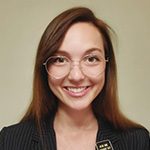No Records Found
Sorry, no records were found. Please adjust your search criteria and try again.
Google Map Not Loaded
Sorry, unable to load Google Maps API.
- Madison
- Brumbaugh
- Virtual Telepractice
Washington
District of Columbia
20016
United States - The Speech Spark, LLC

Washington
District of Columbia
20016
United States
For a child with childhood apraxia of speech, my therapy play-based and involves a small set of words. I like to first focus on sounds that the child can already produce. For example, if the child can already produce the "N" sound sometimes, we may try using it in the word "in" to repeatedly throw a basketball in a basket, or "no" during a question and answer activity, or "on" when turning a battery-operated game off and on. While the target sound may just be the "N" sound for that single session, the words may change so that we practice "N" in different contexts. For example, at the beginning of consonant-vowel (CV) words or at the end of vowel-consonant (VC) words. In my sessions, I also love to introduce sign language, assistive technology, and other tools to support children in case there's ever a communication breakdown. If I can't understand a child, sometimes the child becomes frustrated. To keep the session positive and protect my relationship with the child, I always accept other communication options and encourage the child to problem-solve when these breakdowns occur.
Parents must be involved in the therapy process! To generalize the speech sound skills we're working on in therapy, parents must be involved and can participate in a myriad of ways, from structured practice sessions at home with their child to simply modelling assistive technology use. It's important that parents observe my sessions frequently so that they understand what we're targeting in speech-language therapy and which supports/cues seem to benefit their child most. From these observations and guided teaching from myself, parents can learn to repeat some of the speech-language therapy activities at home. Outside of this, I love establishing open communication with parents so that they are free to share their child's changing interests (so that I can incorporate those interests into sessions) as well as their child's gains at home. Parents play such an important role in progress monitoring!
As a certified assistive technology professional (ATP), I incorporate AAC into all of my sessions. Children are always provided a visual schedule and have access to low-tech AAC materials such as a whiteboard and marker or picture communication icons in case a communication breakdown occurs and we need to quickly problem solve. For children with more complex communication needs, I introduce AAC early with frequent modelling, and I host training sessions for parents new to AAC so that they can learn the importance of modeling at home.




